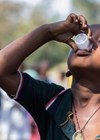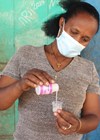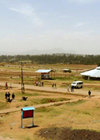Background
Trachoma is one of the oldest diseases known to humankind and the leading infectious cause of blindness worldwide. Spread by the bacterium chlamydia trachomatis, it is transmitted through contact with the eyes, eyelids and nose of those infected.
The disease roughens the inner surface of the eyelids and, if repeated re-infection occurs, the eyelids turn inward, leading to trachomatous trichiasis (TT), where the eyelashes rub against the surface of the eye with each blink. This complication damages the cornea and can cause irreversible blindness.
In the 1800s, trachoma became a public health problem in the UK and Europe as soldiers returned home from the Napoleonic wars with the condition. Eliminated in most industrialised nations by the 1950s, it’s still common in countries with limited access to clean water, sanitation and health services. According to the World Health Organisation (WHO) Weekly Epidemiological Record (July 2023), there are 116 million at risk of trachoma [1], and it is responsible for the blindness and visual impairment of about 1.5 million people worldwide [2].

Lelisa Ammanuel, Senior Disease Prevention and Control Advisor, Ethiopia Ministry of Health, administers the 100-millionth Zithromax dose delivered by Orbis in Ethiopia to Hizkiel, six-years-old on May 9, 2023. Also in attendance was Derek Hodkey, Orbis International President and CEO. ©Genaye Eshetu/Orbis.
In Ethiopia, women account for 70% of those with TT [3], the blinding stage of trachoma. Ethiopia’s more traditional gender roles mean that women are often the main caregivers of children who are the group most likely to have the trachoma infection.
Treatment and prevention, however, is relatively simple, but all steps must be undertaken together to make real and lasting change. The recommended global elimination strategy led by WHO is summarised by the acronym SAFE, which means Surgery for trachomatous trichiasis, Antibiotics to clear active chlamydia trachomatis infection, Facial cleanliness, and Environmental improvements, such as access to toilets, to reduce transmission.
Ethiopia
In Ethiopia, trachoma is the second leading cause of blindness behind cataract and is home to over half the world’s global burden of the disease. Eighty-five percent of Ethiopia’s 123-million population live in rural areas, many in locations which are hard to reach [4,5].
International sight saving organisation Orbis has been working with partners such as Sightsavers, the UK’s Foreign, Commonwealth and Development Office, Irish Aid, CIFF and The End Fund to help decrease trachoma by 91% since 2002 in endemic areas, and this year Orbis and partners delivered their 100-millionth dose of antibiotics. But there is still work to be done to ensure that this disease is eliminated for good.

Alemayehu Sisay, MD MPH, Ophthalmologist and Orbis Ethiopia Country Director, speaks to Eye News about the organisation’s work in Ethiopia. Alemayehu Sisay, MD MPH, Ophthalmologist and Orbis Ethiopia Country Director, speaks to Eye News about the organisation’s work in Ethiopia.
How does trachoma impact the Ethiopian population?
According to WHO, Ethiopia has 55% of the global burden of trachoma and more than 68 million people are at risk of acquiring the active infection [1,6]. There are multiple districts within Ethiopia that require the WHO’s recommended SAFE strategy so that the global elimination target of 2030 can be met.
The SAFE strategy relies upon collaboration, integration and resource mobilisation as surgery for TT alone requires equipment, supplies and training.
The antibiotic of choice for treating trachoma is azithromycin, which is donated to us from Pfizer and which we’re very grateful for. Orbis fronts the distribution costs, and coordination with the Water, Sanitation and Hygiene (WASH) organisations. Focusing on any one strategy in isolation will not address the problem effectively. Working in collaboration with multisectoral organisations gives us confidence that trachoma can be eliminated.
What would eliminating trachoma in Ethiopia feel like to you?
Eliminating trachoma has been linked to nine of the UN’s 17 Sustainable Development Goals (SDGs) because it has positive social, economic and psychological implications. Investing in trachoma elimination is therefore not just about eliminating trachoma but contributing to the bigger picture. I want Ethiopia to benefit from that.
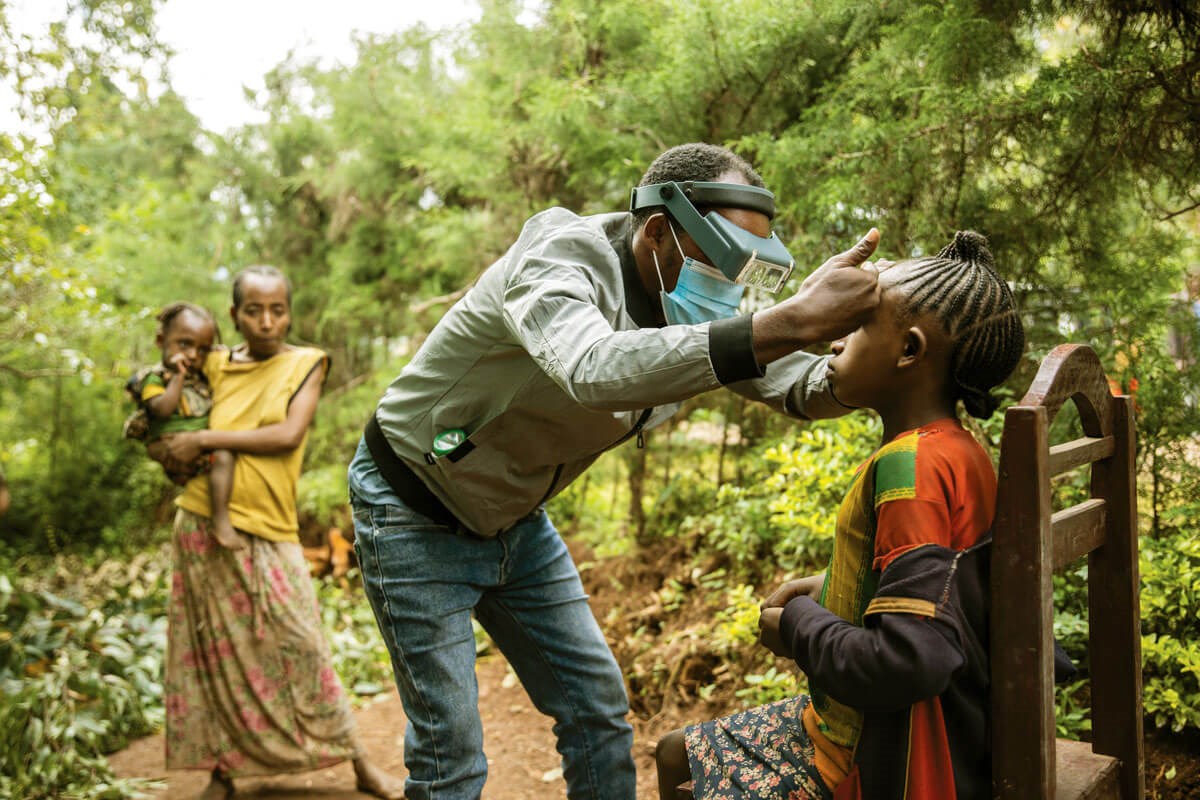
A grader checks a child’s eyes for trachoma during a house-to-house
impact survey in Gedeo Zone. ©Genaye Eshetu/Orbis.
Orbis’ role in this is significant. In southern Ethiopia, where more than 20 million people are living, Orbis is the sole developmental partner working together with the Ministry of Health and regional governments to implement the SAFE strategy. With the contribution of the community, the media, the public and the government, we have made huge strides towards elimination.
Trachoma is a complicated disease to eliminate. What are the barriers that Ethiopia faces?
Trachoma has been called a disease of the ‘poorest of the poor’. In affected communities, people do not have proper healthcare systems or WASH facilities. In short, people do not have access to water.
Trachoma is also said to be a litmus paper for development. If trachoma is a public health problem in communities, it indicates that there is poverty in all dimensions. When it is said that Ethiopia has the global burden of 55%, it has a lot of implications related to this [1].
Women and children are affected most by this painful infection. Can you expand on this?
Trachoma affects women and children more than men in its nature, but it is also related to culture. Mothers tend to be responsible for the childcare, among other things. There is therefore close proximity between a mother and her children. The cycle of infection and re-infection can therefore go on for many years.
The consequence of this is that the progression of trachoma in mothers is more prevalent than in men. The likelihood of women aged 35-40-years of age developing blinding trachoma is four times more common than in males [3].
This is also down to science since it’s an infectious disease being transmitted from one person to another. Seventy-five percent of the surgeries we perform for TT are on women. The active infection is also seen most in the one - nine year age group [7].
Men still suffer with trachoma, but it’s predominantly a disease of mothers and children.
What impact does trachoma have on a child’s life?
The signs of trachoma in children are redness, foreign body sensation, discharge and blurry vision. How could a student with an active infection facing all those clinical signs attend class in a good mindset? The likelihood is that affected children will drop out of school because of the poor vision and the pain.
Eventually, children will develop the blinding form of the disease. To prevent this, we are proposing mass drug administration (MDA) not just once per year, but twice, so that we can limit the spread of infection. I also think collaboration with WASH at a global and local level is so important. Without WASH, it will cause a delay in the elimination effort.
How has the rise in the cost of living (CoL) impacted your work?
The CoL reflects the global experience. Ethiopia is no exception. We have experienced a hike in all economical aspects and in particular, fuel. This means that all the commodities we need to procure for TT interventions and MDA has increased, including the per diem rates for professionals delivering the services.
However, this will not stop us from delivering what we envision, and we will have to be innovative, cautious of the cost implications and find new ways of doing the same thing – with improved quality. Cost is always an issue, but we try to be as efficient as possible.
How will that have impacted the people who are living with trachoma as well?
With CoL skyrocketing, the impact on the poorest of the poor is even worse. I can see that the implication on those communities will be worse. This is one of the reasons we are providing eyecare services free of charge to these communities.
We also cover indirect costs to the patients, such as transportation, meals or overnight stays in rural areas. We cover all those areas to minimise the economic challenges we’re all facing.
Can you outline the role Orbis Ethiopia plays?
We have a team working in Ethiopia with the affected community who provide counselling, surgery, medical treatment and other support. We have conducted more than 300,000 sight-saving surgeries so far in our 25 years of presence in Ethiopia. The team see the big picture of eliminating trachoma and the advantage of a developed community impacting millions. We’ve already delivered over 100-million doses of Zithromax which enabled millions of individuals to escape the disease.
I would like to acknowledge our affiliate Orbis offices. Orbis UK and their tireless fundraising has a direct impact on communities in Ethiopia, and without the continued support, our work would not be possible. So, we hope that will continue until we eliminate trachoma. And then beyond trachoma, there are other non-communicable diseases that we must address.
Case story
Fikir is a biology teacher in Gurage, Ethiopia, and a mother of two children. Fikir contracted repeated trachoma infections in childhood which increased her risk of TT. However, it wasn’t until Fikir attended university, and a friend noticed that she had the disease, that Fikir discovered what was wrong.
“I caught trachoma from my mother when I was young. I didn’t know this was bacteria or trachoma. My eye was getting infected more frequently than usual. When I went to university, my friend saw my eye and diagnosed me with TT. She had a history of assisting her mother by pulling out her eyelashes. That was my first experience of getting eyelashes removed. When my eyelashes grew back, I would do this more frequently. After university, I got married and my husband then helped with this process.
“The disease gives me tearing and redness as well as pain, so it has been difficult to teach in class. Some of my students have had trachoma but one of the 10th-grade students has already gone from the school. He dropped out because of his severe pain.”
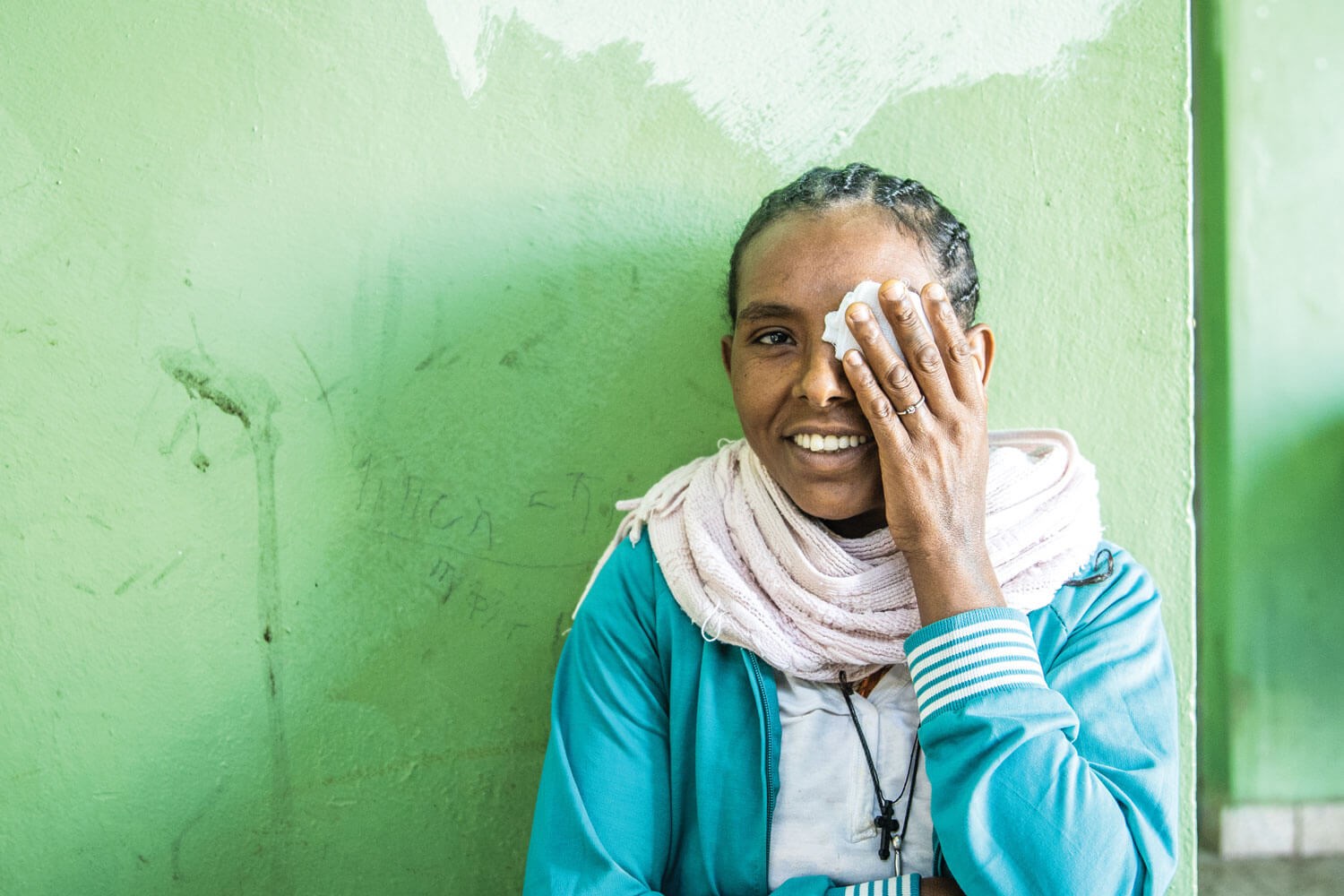
Fikir, 28, is a biology teacher in Gurage Zone, Ethiopia, and was first
infected with trachoma as a child. ©Genaye Eshetu/Orbis.
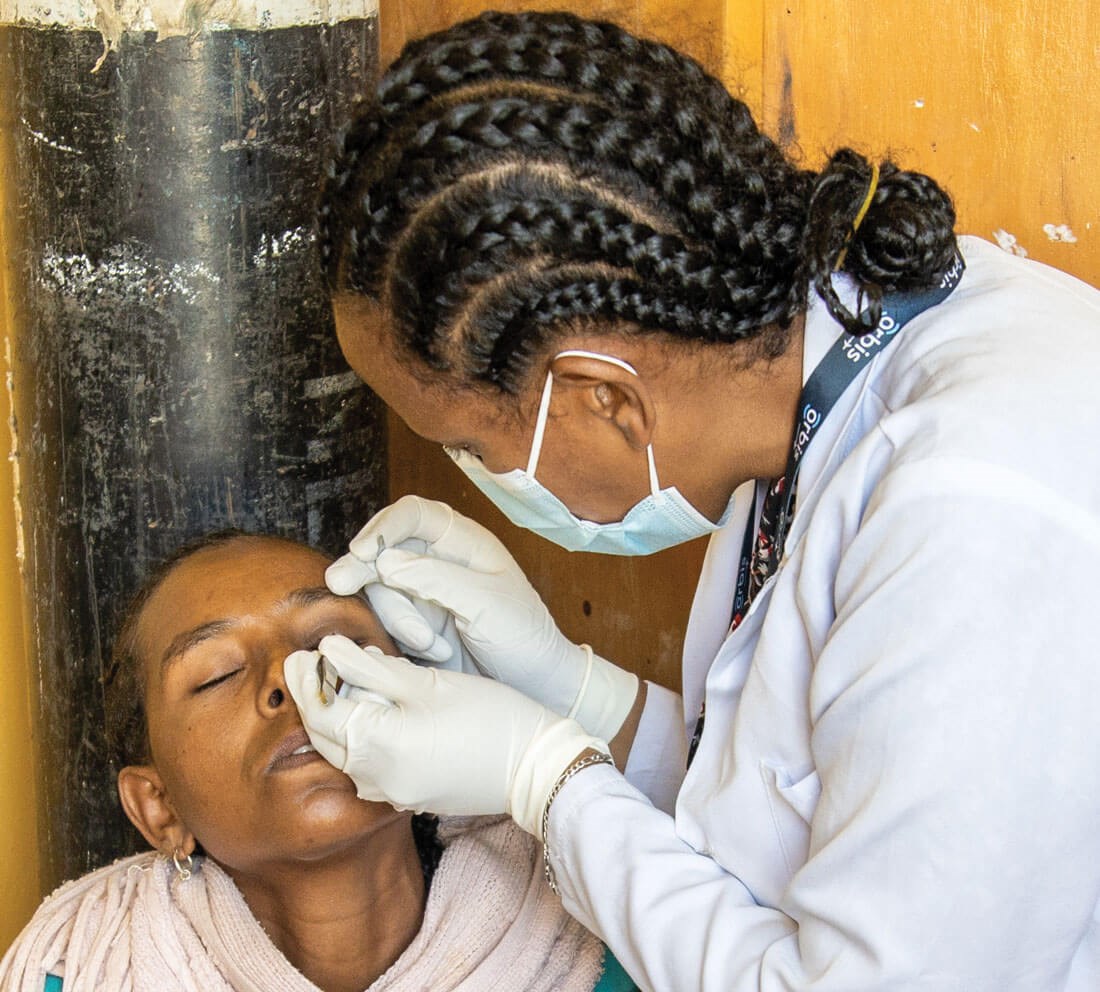
Fikir having her stitches removed at Worsherbe Health Centre after
receiving TT surgery a week before. ©Genaye Eshetu/Orbis.
Orbis met Fikir at Worsherbe Health Centre, Ethiopia, where she had received TT surgery the week before, and was due to have her stitches out.
“For so long I have had a sharp pain in my eye. Thanks to surgery, I will be able to see without discomfort. After my stitches are removed, I am looking forward to being independent once again and seeing the bright light.”
Fikir mentioned both her children are showing early signs of trachoma and she now realises she needs to get them treatment.
“I am a mother of two boys; Gidiam is five-years-old, and Garisadic is two-years-old. They are showing some signs of redness and the discharge has already started. I have brought them to a health centre before. As a mother, I am caring for them as much as possible.”
Orbis have trained the health workers at Worsherbe Health Centre, Gurage Zone, where Fikir received treatment. The team have been trained in TT surgery, as well as how to identify and treat trachoma infections.
Conclusion
Trachoma remains a public health problem in over 40 low- and middle-income countries (LMICs), including Ethiopia where an estimated 8.8 million people live with vision loss today [8].
Is there an end in sight? WHO has now validated the elimination of trachoma in 17 countries worldwide, including Benin and Mali earlier this year. In July, the organisation also announced that trachoma is no longer a public health problem in Iraq. Yet there is still work to be done to eliminate this debilitating disease from Ethiopia.
Orbis has been working towards the WHO goal to eliminate trachoma by 2030, including the implementation of SAFE, for 20 years alongside their partners.
It has been shown that every $1 spent on eye health in LMICs generates $4 of economic gain, helping to break the poverty cycle [9]. Without this investment and innovation in eyecare, vision loss is forecast to triple in Ethiopia by 2050, impacting the lives of even more people and robbing children of their futures [10]. The coming years are therefore the most critical to ensuring a future without trachoma, for good, with Ethiopia at the epicentre in this fight against this terrible disease.
To join Orbis in their fight against trachoma in Ethiopia today, donate at: www.orbis.org.uk/eyenews
TAKE HOME MESSAGES
-
Seventy percent of those affected by blinding trachoma in Ethiopia are women.
-
Just over half of the global burden of trachoma can be found in the country.
-
Trachoma is the leading infectious cause of blindness worldwide and one of the most preventable.
-
The CoL crisis has increased the cost of all commodities required for treating trachoma.
-
Vision loss is forecast to triple in Ethiopia by 2050, without investment and innovation in eye care.
-
Every $1 invested in eye health in LMICs is estimated to generate $4 in economic gain.
References
1. World Health Organisation. Weekly Epidemiological Record 2023;98(28):310.
2. World Health Organisation. Trachoma (2022).
https://www.who.int/news-room/
fact-sheets/detail/trachoma
3. Cromwell EA, Courtright P, King JD, et al. The excess burden of trachomatous trichiasis in women: a systematic review and meta-analysis. Trans R Soc Trop Med Hyg 2009;103(10):985-92.
4. Embassy of Ethiopia Washington DC. About Ethiopia.
https://ethiopianembassy.org/
overview-about-ethiopia
5. The World Bank. Population, total – Ethiopia (2022).
https://data.worldbank.org/indicator/
SP.POP.TOTL?locations=ET
6. World Health Organisation. Weekly Epidemiological Record 2023;98(28):301.
7. World Health Organisation. Weekly Epidemiological Record 2023;98(28):298.
8. IAPB Vision Atlas. Country Map & Estimates of Vision Loss: Ethiopia (2020).
https://www.iapb.org/learn/vision-atlas/
magnitude-and-projections/countries/ethiopia/
9. PricewaterhouseCoopers (PwC) and Fred Hollows Foundation. Investing in Vision: The Costs and Benefits of Ending Avoidable Blindness (2013).
https://www.hollows.org/Upload/FHFV3/Media/
au/pdf/Other%20file%20downloads/PwC
-Investing-in-Vision-Summary-Brochure.pdf
10. Bourne RAR, Flaxman SR, Braithwaite T, et al. Magnitude, temporal trends, and projections of the global prevalence of blindness and distance and near vision impairment: a systematic review and meta-analysis. Lancet Glob Health 2017;5(9):e895.
[all links last accessed September 2023]
COMMENTS ARE WELCOME





